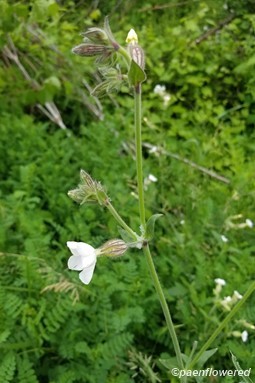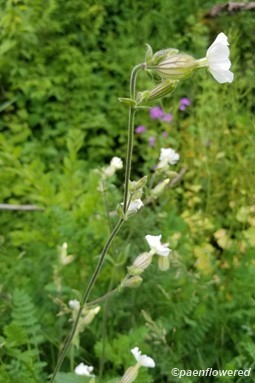Silene latifolia
An alien white wildflower that blooms at night
Silene latifolia white campion
Add to MyPlants View Locations
This plant from the pink family grows in waste areas, along roadsides, in vacant lots, in cemeteries, along banks of streams and along fence edges. It does best, however, in sunny locations with rich, well-drained alkaline soils.
It can grow from one to three feet tall and has a hairy sticky stem, probably to exclude crawling insects. It blooms from June to September producing one-inch white flowers. These flowers have five petals with deeply notched edges, and it has an inflated tubular calyx with green or maroon veins. The base of the petals has upturned fringe that forms a collar around the center of the flower.
This species tends to bloom at night, releasing specific pheromone scents that attract moths as pollinators. Therefore it is sometimes difficult to find one open during the day. The plant has separate male and female flowers. The female flower has five elongated styles that curl out of the collar and 20 veins on the calyx. The male flower has a more slender 10-veined calyx with ten short white stamens.
White campion is normally an annual plant, but occasionally can be biennial or a short-lived perennial plant. The fruit is a brown or tan urn-shaped capsule with ten spreading teeth. When it opens to release the seeds it sheds a papery covering. A single female plant can produce up to 24,000 seeds in a season.
When the plant is young there is a basal rosette of leaves, but later stem leaves are formed. The stem leaves are opposite and ovate or lance-shaped and 4-10 centimeters long. The entire plant is densely hairy. These can be boiled and eaten. Uncooked they have a bitter taste. Leaf extracts are highly toxic to mosquito larvae. Saponin, a chemical from the roots, has long been used to make soap, though it is slightly toxic.
Habitat & Range
Grows along roadsides, and in other man-disturbed habitats.
Present in all counties of the state.
Range: Widespread in the United States, especially in the North.
Wetland code: Not classified
Phenology
Flowers June to September.
Silene latifolia white campion
Synonyms: Lychnis albaAdd to MyPlants View Locations











Comments
Have you spotted this plant in your area? We'd love to hear about your experience! Share your comments or questions about the plant below. Comments are moderated before posting.